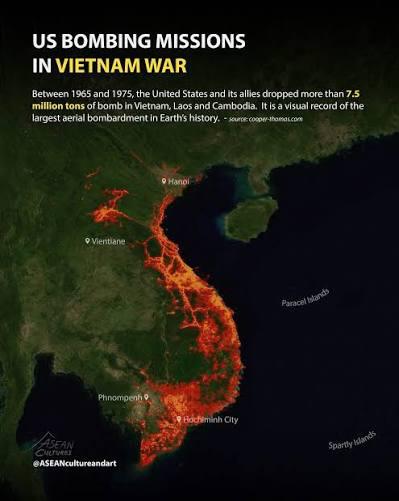US Bombing in Vietnam, Laos, Cambodia Map


Alex Cartwright
Senior Cartographer & GIS Specialist
Alex Cartwright is a renowned cartographer and geographic information systems specialist with over 15 years of experience in spatial analysis and data...
Geographic Analysis
What This Map Shows
This map provides a stark visualization of the extensive bombing campaigns conducted by the United States during the Vietnam War, specifically focusing on the territories of Vietnam, Laos, and Cambodia. The map highlights the locations and intensity of bombing operations, revealing the geographical spread of military actions that significantly impacted these regions. The sheer scale of the bombings, often hidden in the broader context of the war, is essential to understand the profound consequences these actions had on the local populations and environments.
Deep Dive into US Bombing Operations
The U.S. bombing campaigns in Southeast Asia, particularly in Vietnam, Laos, and Cambodia, were unprecedented in their scale and ferocity. Initiated in the 1960s, these operations aimed to disrupt the supply routes of the North Vietnamese Army and the Viet Cong, particularly along the Ho Chi Minh Trail, which traversed Laos and Cambodia. Over the course of the war, it is estimated that over 2.7 million tons of ordnance were dropped on Vietnam alone, a figure that surpasses the total bomb tonnage used by the Allies in World War II.
Interestingly, the strategy behind the bombings was not just to target military installations but also to devastate the agricultural capacity of the region, thereby undermining the local support for communist forces. This tactic led to the widespread use of herbicides, such as Agent Orange, which have had lasting health and environmental effects on the region. The bombing campaigns resulted in severe deforestation, soil degradation, and contamination of water sources, severely impacting local communities.
In Laos, where the U.S. conducted one of the most intense bombing campaigns in history, the situation was dire. The country became one of the most bombed nations per capita in the world. In total, over 580,000 bombing missions were flown over Laos, an effort that was largely covert and remained largely unacknowledged at the time. The legacy of unexploded ordnance (UXO) still poses a significant danger to the population today, hindering development and causing numerous casualties each year.
Cambodia also suffered immensely from U.S. bombing operations. In an effort to target North Vietnamese troops that had crossed into Cambodian territory, the U.S. dropped bombs indiscriminately across the countryside. This not only destabilized the Cambodian government but also contributed to the rise of the Khmer Rouge, whose brutal regime was partly a reaction to the chaos wrought by the bombings. The implications of these campaigns have reverberated through the decades, shaping the political and social landscape of these countries.
Regional Analysis
When analyzing the impact of U.S. bombing in these three countries, distinct regional characteristics emerge. In Vietnam, the bombings were concentrated in the southern regions, particularly around major cities like Ho Chi Minh City (formerly Saigon) and the Mekong Delta. Here, the focus was on disrupting supply lines and military operations. The legacy of this destruction is evident in the dense cluster of bomb craters and the long-term effects on agriculture and health in the area.
Conversely, the bombing of Laos was characterized by a lack of strategic military targets, leading to widespread civilian casualties. The northern regions of Laos, particularly near the Plain of Jars, were heavily affected. The sheer volume of bombs dropped has left many areas littered with UXOs, which continue to pose threats to local communities.
In Cambodia, the bombings were particularly concentrated around the border regions, affecting rural populations. The socioeconomic impact was catastrophic, leading to displacement and contributing to the rise of the Khmer Rouge. The aftermath saw a country struggling to recover from the dual traumas of bombing and subsequent genocide.
Significance and Impact
The significance of understanding the U.S. bombing campaigns in Vietnam, Laos, and Cambodia cannot be overstated. These military actions have had lasting ramifications on the geopolitical landscape of Southeast Asia, influencing regional politics, social structures, and economic stability. Today, the consequences of these bombings are still felt, as many communities continue to deal with the dangers posed by unexploded ordnance and the health impacts of chemical agents used during the war.
Moreover, the historical context of these bombings sheds light on contemporary military strategies and their ethical considerations. As nations engage in military actions around the world, the lessons learned from the Vietnam War highlight the need for accountability and awareness of the long-term consequences of warfare on civilian populations. The ongoing efforts for demining and health recovery in Vietnam, Laos, and Cambodia reflect both the challenges and resilience of communities that have endured the scars of war.
In conclusion, the map of U.S. bombing in Vietnam, Laos, and Cambodia serves as a powerful reminder of the complexities of war and its far-reaching effects on geography, society, and history. Understanding these impacts helps foster a deeper appreciation for the region's ongoing recovery and the importance of peace-building efforts in post-conflict societies.
Visualization Details
- Published
- October 11, 2025
- Views
- 52
Comments
Loading comments...